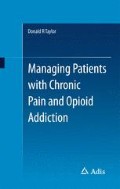Abstract
As patients with chronic, noncancer, pain (CP) are often treated with chronic opioid therapy (COT), there is a need for physicians and healthcare teams to be aware of what aberrant drug-related behavior is and how to detect it. The goal is to detect patients developing problems (aberrant behaviors) and intervene before they progress to addiction.
Access this chapter
Tax calculation will be finalised at checkout
Purchases are for personal use only
Preview
Unable to display preview. Download preview PDF.
References
Corsini E, Zacharoff KL. Definitions related to aberrant drug-related behavior: Is there correct terminology? PainEdu.org. www.painedu.org/articles_timely.asp?ArticleNumber=58. Published October 29, 2011. Accessed September 18, 2014.
Savage SR, Horvath R. Opioid Therapy of Pain, In: Ries R, ed. Principles of Addiction Medicine. 4th edn. Philadelphia, PA: Lippincott Williams & Wilkins; 2009:1329-1353.
Weaver M, Schnoll S. Abuse liability in opioid therapy for pain treatment in patients with an addiction history. Clin J Pain. 2002;18:S61-S69.
Policy Impact: Prescription Painkiller Overdoses. Centers for Disease Control and Prevention, National Center for Injury Prevention and Control, Division of Unintentional Injury Prevention. www.cdc.gov/homeandrecreationalsafety/rxbrief/. July 2, 2013. Accessed September 18, 2014.
Editorial Board. FDA seeks to curb abuse of prescription painkillers. The Washington Post. Published: October 28, 2013.
Fishbain DA, Cole B, Lewis J, et al. What percentage of chronic nonmalignant pain patients exposed to chronic opioid analgesic therapy develop abuse/addiction and/or aberrant drugrelated behaviors? A structured evidence based review. Pain Med. 2008;9:444-459.
Portenoy RK, Farrar JT, Backonja MM. Long-term use of controlled-release oxycodone for noncancer pain: results of a 3 year study. Clin J Pain. 2007;23:287-299.
Manchikanti L, Cash KA, Damron KS, et al. Controlled substance abuse and illicit drug use in chronic pain patients: An evaluation of multiple variables. Pain Physician. 2006;9:215-225.
Gourlay D L, Heit HA, Almahrezi A. Universal precautions in pain medicine: A rational approach to the treatment of chronic pain. Pain Medicine. 2005; 6:107-112.
Passik SD, Weinreb HJ. Managing chronic nonmalignant pain: Overcoming obstacles to the use of opioids. Adv Ther. 2000;17:70-83.
Savage SR. Opioid Therapy of Pain, In: Ries R, ed. Principles of Addiction Medicine. 5th edn. Philadelphia, PA: Lippincott Williams & Wilkins; 2014:1522.
Zeppetella G. Breakthrough pain in cancer patients. Clin Oncol (R Coll Radiol). 2011:23:393-398.
Christie JM, Simmonds M, Patt R, et al. Dose-titration, multicenter study of oral transmucosal fentanyl citrate for the treatment of breakthrough pain in cancer patients using transdermal fentanyl for persistent pain. J Clin Oncol. 1998;16:3238-3245.
Messina J, Darwish M, Fine PG. Fentanyl buccal tablet. Drugs Today (Barc). 2008;44:41-54.
Vadivelu N, Chen IL, Kodumudi V, et al. The implications of urine drug testing in pain management. Curr Drug Saf. 2010;5:267-270.
TIRF REMS ACCESS. TIRF REMS Access Program Home. What is the TIRF REMS Access Program? www.tirfremsaccess.com. Accessed September 18, 2014.
Author information
Authors and Affiliations
Corresponding author
Rights and permissions
Copyright information
© 2015 Springer International Publishing Switzerland
About this chapter
Cite this chapter
Taylor, D.R. (2015). Monitoring patients with chronic pain and addiction. In: Managing Patients with Chronic Pain and Opioid Addiction. Adis, Cham. https://doi.org/10.1007/978-3-319-08111-3_3
Download citation
DOI: https://doi.org/10.1007/978-3-319-08111-3_3
Published:
Publisher Name: Adis, Cham
Print ISBN: 978-3-319-08110-6
Online ISBN: 978-3-319-08111-3
eBook Packages: MedicineMedicine (R0)

